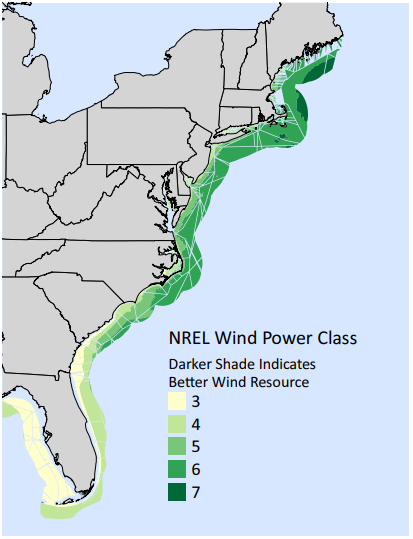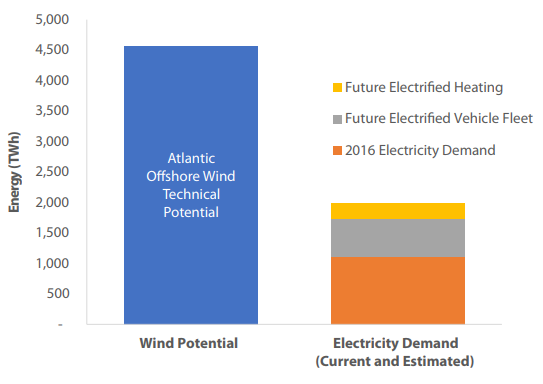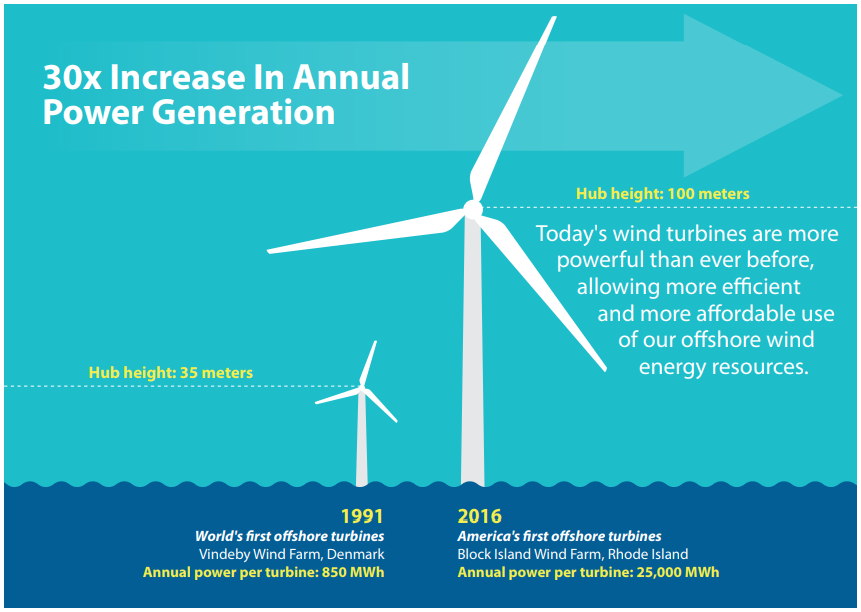Wind Power to Spare: The Enormous Energy Potential of Atlantic Offshore Wind
The Atlantic coast states are dependent on fossil fuels, which pollute our air, put our health at risk, and contribute to global warming. In response, states in the region are moving toward an energy system powered by clean, renewable sources: Atlantic states now generate enough wind and solar energy to power nearly 2 million homes, 19 times more than just a decade ago.
Downloads
Executive Summary
The Atlantic coast states are dependent on fossil fuels, which pollute our air, put our health at risk, and contribute to global warming. In response, states in the region are moving toward an energy system powered by clean, renewable sources: Atlantic states now generate enough wind and solar energy to power nearly 2 million homes, 19 times more than just a decade ago.
Yet to achieve a truly clean energy system, Atlantic states – which account for more than a quarter of the nation’s energy use – will need to tap into a massive clean energy resource that is right in our back yard: offshore wind energy.
With enough wind energy resources to generate four times the amount of electricity the region currently consumes, offshore wind can help power the Atlantic coast with clean energy. In order to capture this tremendous pollution-free resource, state leaders must put in place strong policies to foster development of offshore wind, while ensuring the protection of our oceans and wildlife.
Offshore wind is an abundant resource located close to where we need it most, and it can play a core role alongside other renewable energy sources in providing clean energy for the future.
- Offshore wind off the Atlantic states could produce enough electricity each year to meet four times those states’ electricity consumption (4,574 terawatt hours), even after excluding areas not suitable for current technology and off-limits areas like shipping lanes. Almost every Atlantic state (12 out of 14) has wind potential off its shores that exceeds current state electricity consumption.
- Tapping into offshore wind can help meet future electricity demand created by electrifying activities currently powered by gasoline, natural gas and other fossil fuels, like transportation and heating homes and businesses. If developed to its full potential, Atlantic offshore wind could supply double the estimated electricity it would take to power all current electricity needs plus estimated electricity for electrified heating and electric vehicles.
Figure ES-1. Offshore Wind Energy Potential on the Atlantic Coast

Figure ES-2. Offshore Wind Has the Technical Potential to Supply Double the Energy Demand for Current Electricity Needs Plus Estimated Demand for Electrified Vehicles and Heating

Offshore wind technology is advanced, affordable and proven.
- Offshore wind is proven. Europe is home to 4,100 offshore wind turbines that supply enough electricity to power more than 20 million homes each day. In Denmark, offshore wind supplied 15 percent of electricity use over the first half of 2017.
- Offshore wind turbine is advanced, and can generate more power, more efficiently than ever before. For example, the turbines at the nation’s first offshore wind project in Rhode Island produce 30 times more electricity each year than the first offshore wind turbines installed in Europe in the early 1990s.
- Offshore wind has become affordable. According to Lazard, the average global levelized cost of energy for new offshore wind fell by 27 percent from 2012 to 2017, to a cost that is comparable to a new coal-fired power plant and cheaper than a new nuclear plant over the plants’ entire life cycles.
- Experts predict that offshore wind will continue to fall in price. Bloomberg New Energy Finance projects that the levelized cost of energy for offshore wind will fall by 71 percent by 2040 relative to today’s prices.
- Experience at home and abroad has shown that responsible development of offshore wind can avoid harm to the environment and wildlife, including the North Atlantic right whale.
Figure ES-3. Turbines at Block Island Wind Farm Produce 30 Times More Electricity Each Year Than the First Offshore Turbines from 1991

Offshore wind projects are already planned all along the Atlantic coast.
- More than 8 gigawatts (GW) of offshore wind development are supported by state policy in five Atlantic states. If state offshore wind targets and commitments are met, offshore wind in those states would be able to generate electricity equivalent to the power used by 3 million homes.
- As of February 2018, 13 Atlantic offshore wind projects had leases and were moving forward. With a total estimated capacity of 14.2 GW, these proposed projects could power approximately 5.2 million homes.
- These in-development offshore wind projects could produce a fifth as much energy as we could get annually from Atlantic offshore oil and gas, based on optimistic production estimates from the American Petroleum Institute, an industry trade group. Capacity of the proposed projects represents just 1 percent of Atlantic offshore wind technical potential.
Figure ES-4. Capacity of Proposed Atlantic Offshore Wind Projects by State and Project Status

Securing a long-term agreement for the sale of electricity (an “offtake” agreement) is an important step in the development of offshore wind projects. These can take forms including power purchase agreements and renewable energy credit agreements.
Offshore wind has the potential to help repower the Atlantic coast with clean energy – but taking advantage of the opportunity will require support from policymakers and regulatory bodies. Supportive policies include strong and enforceable state offshore wind targets, policies to ensure a strong market for offshore wind, investments in research, and efforts to work with the federal Bureau of Ocean Energy Management to ensure environmentally responsible and efficient development of offshore wind resources. Policymakers must also create minimum standards for the protection of ocean habitats and wildlife (particularly the North Atlantic right whale).

